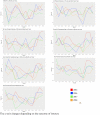Seasonality of adverse birth outcomes in women with and without HIV in a representative birth outcomes surveillance study in Botswana
- PMID: 34479931
- PMCID: PMC8420660
- DOI: 10.1136/bmjopen-2020-045882
Seasonality of adverse birth outcomes in women with and without HIV in a representative birth outcomes surveillance study in Botswana
Abstract
Introduction: Sub-Saharan Africa has the largest number of people with HIV, one of the most severe burdens of adverse birth outcomes globally and particular vulnerability to climate change. We examined associations between seasonality and adverse birth outcomes among women with and without HIV in a large geographically representative birth outcomes surveillance study in Botswana from 2015 to 2018.
Methods: We evaluated stillbirth, preterm delivery, very preterm delivery, small for gestational age (SGA), very SGA, and combined endpoints of any adverse or severe birth outcome. We estimated the risk of each outcome by month and year of delivery, and adjusted risks ratios (ARRs) of outcomes during the early wet (1 November-15 January), late wet (16 January-31 March) and early dry (1 April-15 July) seasons, compared with the late dry (16 July-31 October) season. Analyses were conducted overall and separately by HIV status.
Results: Among 73 178 women (24% with HIV), the risk of all adverse birth outcomes peaked in November-January and reached low points in September. Compared with the late dry season, the ARRs for any adverse birth outcome were 1.03 (95% CI 1.00 to 1.06) for the early dry season, 1.08 (95% CI 1.04 to 1.11) for the early wet season and 1.07 (95% CI 1.03 to 1.10) for the late wet season. Comparing the early wet season to the late dry season, we found that ARRs for stillbirth and very preterm delivery were higher in women with HIV (1.23, 95% CI 0.96 to 1.59, and 1.33, 95% CI 1.10 to 1.62, respectively) than in women without HIV (1.07, 95% CI 0.91 to 1.26, and 1.19, 95% CI 1.04 to 1.36, respectively).
Conclusions: We identified a modest association between seasonality and adverse birth outcomes in Botswana, which was greatest among women with HIV. Understanding seasonal patterns of adverse birth outcomes and the role of HIV status may allow for mitigation of their impact in the face of seasonal extremes related to climate change.
Keywords: HIV & AIDS; epidemiology; obstetrics; perinatology; public health.
© Author(s) (or their employer(s)) 2021. Re-use permitted under CC BY-NC. No commercial re-use. See rights and permissions. Published by BMJ.
Conflict of interest statement
Competing interests: None declared.
Figures
Similar articles
-
Impact of prophylactic antimalarials in pregnant women living with Human Immunodeficiency Virus on birth outcomes in Botswana.Trop Med Int Health. 2022 Nov;27(11):990-998. doi: 10.1111/tmi.13823. Epub 2022 Oct 31. Trop Med Int Health. 2022. PMID: 36183175 Free PMC article.
-
Modest reduction in adverse birth outcomes following the COVID-19 lockdown.Am J Obstet Gynecol. 2021 Jun;224(6):615.e1-615.e12. doi: 10.1016/j.ajog.2020.12.1198. Epub 2020 Dec 24. Am J Obstet Gynecol. 2021. PMID: 33347842 Free PMC article.
-
Association of Severe Acute Respiratory Syndrome Coronavirus 2 (SARS-CoV-2) Infection With Maternal Mortality and Neonatal Birth Outcomes in Botswana by Human Immunodeficiency Virus Status.Obstet Gynecol. 2023 Jan 1;141(1):135-143. doi: 10.1097/AOG.0000000000005020. Epub 2022 Nov 30. Obstet Gynecol. 2023. PMID: 36701614 Free PMC article.
-
Risk of stillbirth, preterm delivery, and fetal growth restriction following exposure in a previous birth: systematic review and meta-analysis.BJOG. 2018 Jan;125(2):183-192. doi: 10.1111/1471-0528.14906. Epub 2017 Oct 3. BJOG. 2018. PMID: 28856792
-
Adverse perinatal outcomes associated with prenatal exposure to protease-inhibitor-based versus non-nucleoside reverse transcriptase inhibitor-based antiretroviral combinations in pregnant women with HIV infection: a systematic review and meta-analysis.BMC Pregnancy Childbirth. 2023 Jan 30;23(1):80. doi: 10.1186/s12884-023-05347-5. BMC Pregnancy Childbirth. 2023. PMID: 36717801 Free PMC article.
Cited by
-
A time-stratified, case-crossover study of heat exposure and perinatal mortality from 16 hospitals in sub-Saharan Africa.Nat Med. 2024 Nov;30(11):3106-3113. doi: 10.1038/s41591-024-03245-7. Epub 2024 Sep 3. Nat Med. 2024. PMID: 39227446 Free PMC article.
-
Subsequent pregnancies in the IMPAACT 2010/VESTED Trial: high rate of adverse outcomes in women living with HIV.J Acquir Immune Defic Syndr. 2024 Oct;97(2):150-155. doi: 10.1097/QAI.0000000000003473. J Acquir Immune Defic Syndr. 2024. PMID: 39742354 Clinical Trial.
References
-
- World Health Organization . Every newborn: an action plan to end preventable deaths 2014.
-
- Suy A, Martínez E, Coll O, et al. . Increased risk of pre-eclampsia and fetal death in HIV-infected pregnant women receiving highly active antiretroviral therapy. AIDS 2006;20:59–66. 10.1097/01.aids.0000198090.70325.bd - DOI - PubMed
Publication types
MeSH terms
Grants and funding
LinkOut - more resources
Full Text Sources
Medical
Miscellaneous


